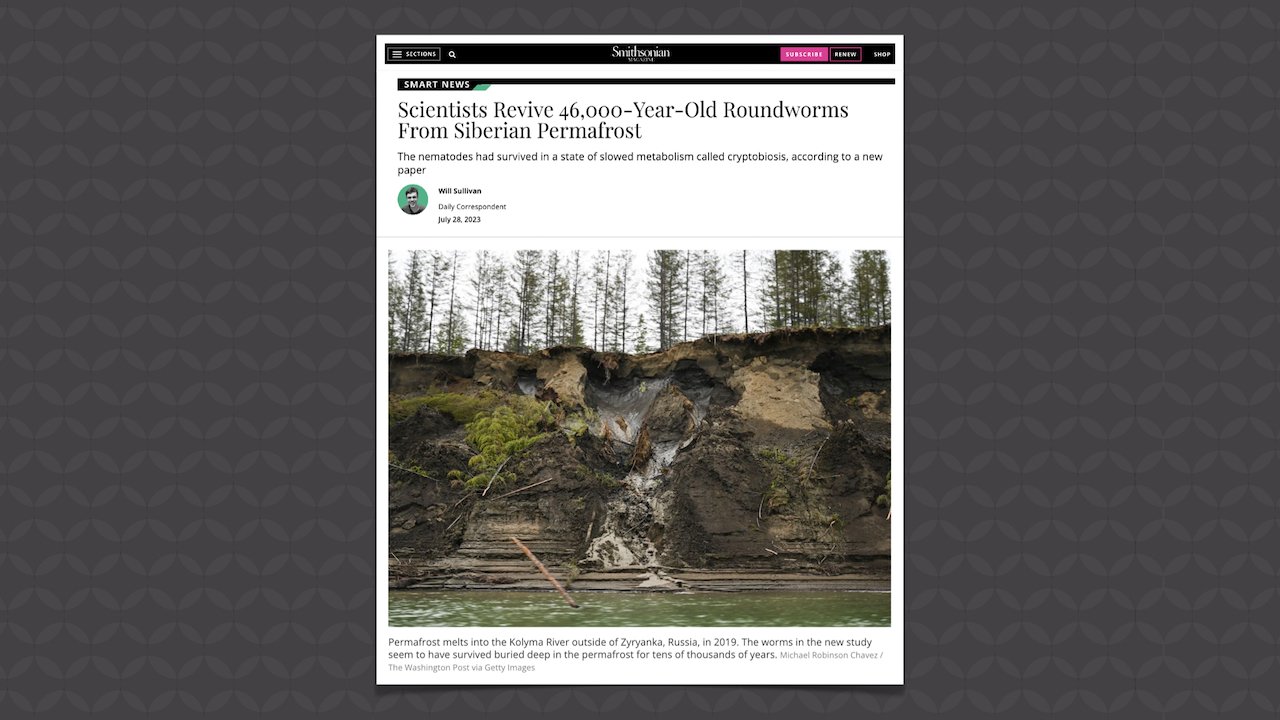
Did Scientists Revive 46,000-Year-Old Roundworms?
Deep in Siberian permafrost lurk microscopic roundworms frozen in time, just waiting for a thaw so they can emerge to infect a host and continue their life cycle. These parasitic creatures are known as nematodes, and they have the ability to “freeze” (reduce their metabolic rate to extremely low levels) for seemingly long periods of time. But are they really emerging from a 46,000-year state of cryptobiosis, as the media is reporting?
Radiocarbon dating is based on a stack of unprovable assumptions.
Well, the ages of these creatures were determined by “radiocarbon dating plant material also found in the permafrost.” So the worms themselves weren’t dated; the material they were buried in was dated. But radiocarbon dating is based on a stack of unprovable assumptions.
As we explain more fully in an article on our website, for radiocarbon dating (also called carbon-14 dating) to be considered accurate, scientists must assume the following:
- The production rate of carbon-14 has always been the same in the past as now.
- The atmosphere has had the same carbon-14 concentration in the past as now.
- The biosphere (the places on earth where organisms live) has always had the same overall carbon-14 concentration as the atmosphere due to the rapid transfer of carbon-14 atoms from the atmosphere to the biosphere.
None of these assumptions can be proven! And it’s worth noting that carbon-14 shouldn’t exist in detectable levels beyond 50,000–100,000 years, and yet carbon-14 has been detected in fossils, coal, and even diamonds—all of which evolutionists assume to be millions or even billions of years old. So, radiocarbon dating is not consistent with an evolutionary worldview (which is exactly what we’d expect since we know the earth is only thousands of years old, based on the eyewitness testimony of the perfect Creator).
Now, when these nematodes were “defrosted” from the permafrost, they began wiggling around, eating, and even reproducing. They have short lifespans, merely a month or two, so the original, supposedly 46,000-year-old nematodes have since died, but their offspring are surviving nicely.
In a biblical worldview, we understand that the permafrost isn’t tens of thousands of years old.
It really does strain credulity to believe that a creature could be “frozen” for 46,000 years only to emerge perfectly normal after all those millennia. But in a biblical worldview, we understand that the permafrost isn’t tens of thousands of years old. At the very most, it was formed during the post-flood ice age (generated by the flood) just a few thousand years ago.
So, no—scientists didn’t revive 46,000-year-old creatures. These microscopic little worms were “frozen in time” a few thousand years ago at the most and have used their God-given ability of cryptobiosis to survive until today.
Get More Answers on Answers News
This item was discussed today on Answers News with cohosts Dr. Georgia Purdom, Jessica Jaworski, and Rob Webb. Answers News is our weekly news program filmed live before a studio audience here at the Creation Museum and broadcast on our Answers in Genesis YouTube channel and posted to Answers TV. We also covered the following topics:
- Our universe was never empty, say scientists.
- Study reveals troubling new marriage trend.
- Another gloomy climate prediction—will it come true?
- And more!
Watch the entire episode of Answers News for August 7, 2023.
Be sure to join us each Monday at 2 p.m. (ET) on YouTube or later that day on Answers TV for Answers News. You won’t want to miss this unique news program that gives science and culture news from a distinctly biblical and Christian perspective.
Thanks for stopping by and thanks for praying,
Ken
This item was written with the assistance of AiG’s research team.
Most Recent News
-
Dec. 23, 2025 from Ken Ham Blog
A recent news item caught my eye when I saw the headline: “18,000 dinosaur tracks discovered along ancient Bolivian coastline.”
-
Dec. 22, 2025 from Ken Ham Blog
“Why should God have anything against there being four of them rather than two?” is the question a clergywoman in Germany asked recently.

Answers in Genesis is an apologetics ministry, dedicated to helping Christians defend their faith and proclaim the good news of Jesus Christ.
- Customer Service 800.778.3390
- Available Monday–Friday | 9 AM–5 PM ET
- © 2025 Answers in Genesis



